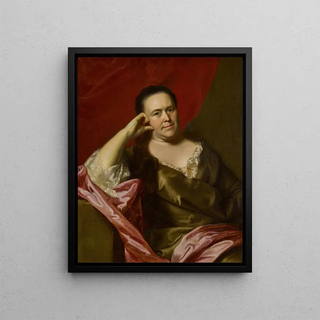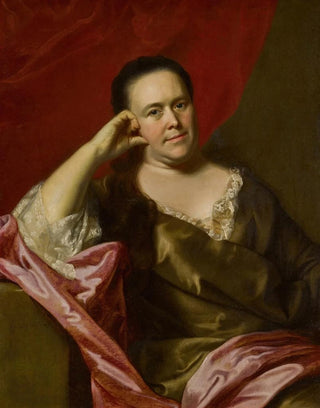Art print | Mme John Scollay, Mercy Greenleaf - John Singleton Copley


View from behind

Frame (optional)
In the captivating world of 18th-century painting, the art print "Mme John Scollay, Mercy Greenleaf" by John Singleton Copley stands out for its psychological depth and technical skill. This depiction of a woman with a gaze that is both gentle and penetrating invites the viewer to delve into the intimacy of the captured moment. Copley, master of portraiture, manages to transcend mere representation to offer a true study of character. The light caressing Mercy Greenleaf's face and the exquisite details of her attire testify to an era when art served to immortalize personalities and emotions. Exploring this work reveals not only a historical figure but also the subtleties of a bygone era.
Style and uniqueness of the work
Copley's style is characterized by striking realism, a painting technique that highlights textures and nuances of the skin. In "Mme John Scollay, Mercy Greenleaf," each brushstroke seems to tell a story. The drapery of the dress, finely rendered, and the choice of colors evoke a richness and sophistication that reflect the social status of the protagonist. The composition is carefully balanced, with a simple background that emphasizes the central figure. This stylistic choice allows the observer to focus on Mercy's expression and posture, thus enhancing the emotional connection. The work does not merely depict a woman; it evokes a personality, a story, and an universe.
The artist and his influence
John Singleton Copley, born in Boston in 1738, is often regarded as one of the greatest portraitists of his time. His ability to capture not only physical appearance but also the psychology of his subjects marked an evolution in portrait art. Influenced by European masters, Copley developed a distinctive style, combining precision and emotion. His works contributed to shaping American artistic identity, establishing standards of quality that still endure today. By painting emblematic figures of his era, he succeeded in immortalizing the spirit of a nation in full transformation, while establishing himself as a pioneer in

Matte finish

View from behind

Frame (optional)
In the captivating world of 18th-century painting, the art print "Mme John Scollay, Mercy Greenleaf" by John Singleton Copley stands out for its psychological depth and technical skill. This depiction of a woman with a gaze that is both gentle and penetrating invites the viewer to delve into the intimacy of the captured moment. Copley, master of portraiture, manages to transcend mere representation to offer a true study of character. The light caressing Mercy Greenleaf's face and the exquisite details of her attire testify to an era when art served to immortalize personalities and emotions. Exploring this work reveals not only a historical figure but also the subtleties of a bygone era.
Style and uniqueness of the work
Copley's style is characterized by striking realism, a painting technique that highlights textures and nuances of the skin. In "Mme John Scollay, Mercy Greenleaf," each brushstroke seems to tell a story. The drapery of the dress, finely rendered, and the choice of colors evoke a richness and sophistication that reflect the social status of the protagonist. The composition is carefully balanced, with a simple background that emphasizes the central figure. This stylistic choice allows the observer to focus on Mercy's expression and posture, thus enhancing the emotional connection. The work does not merely depict a woman; it evokes a personality, a story, and an universe.
The artist and his influence
John Singleton Copley, born in Boston in 1738, is often regarded as one of the greatest portraitists of his time. His ability to capture not only physical appearance but also the psychology of his subjects marked an evolution in portrait art. Influenced by European masters, Copley developed a distinctive style, combining precision and emotion. His works contributed to shaping American artistic identity, establishing standards of quality that still endure today. By painting emblematic figures of his era, he succeeded in immortalizing the spirit of a nation in full transformation, while establishing himself as a pioneer in






